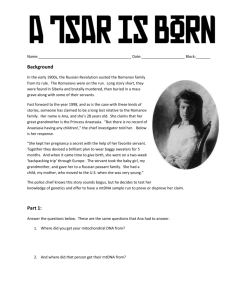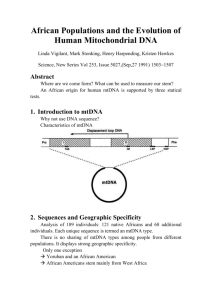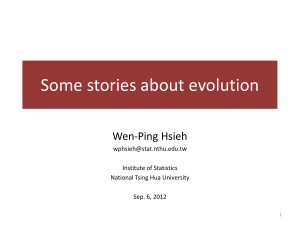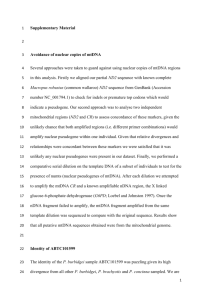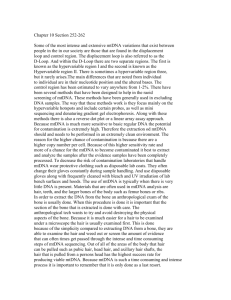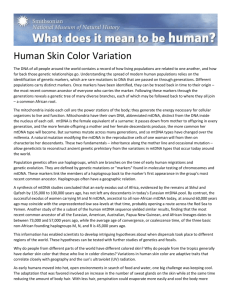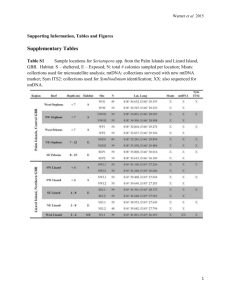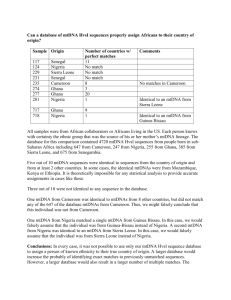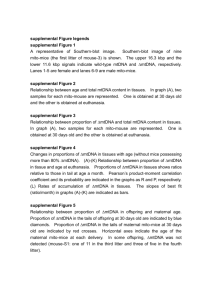mec12745-sup-0001-AppendixS1
advertisement
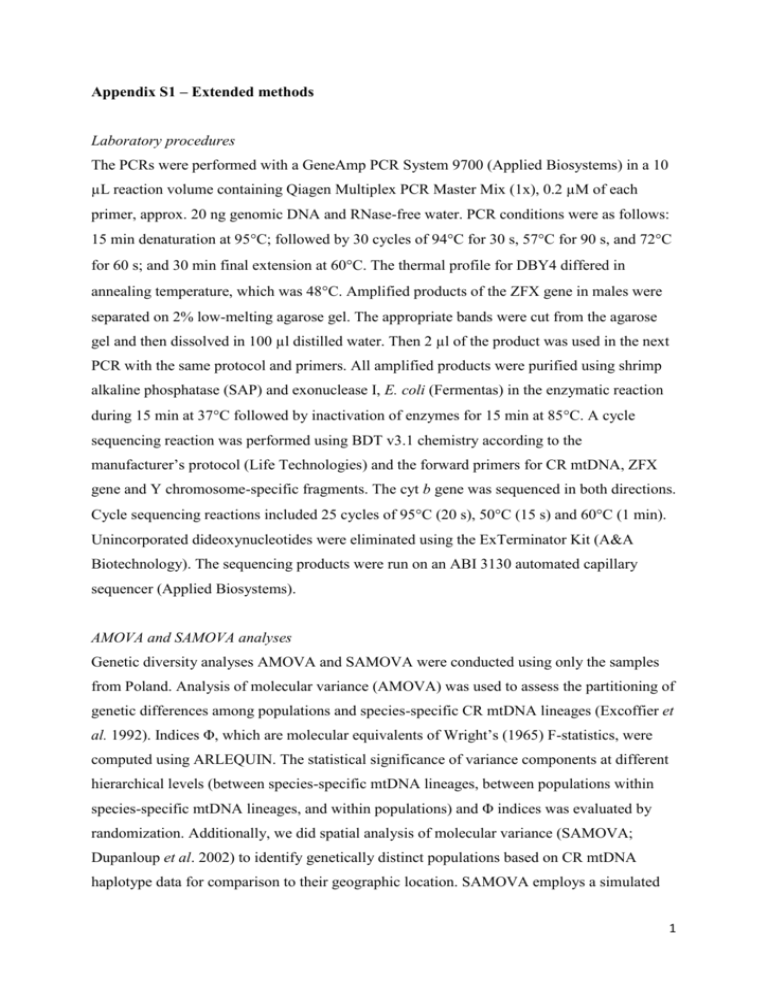
Appendix S1 – Extended methods Laboratory procedures The PCRs were performed with a GeneAmp PCR System 9700 (Applied Biosystems) in a 10 µL reaction volume containing Qiagen Multiplex PCR Master Mix (1x), 0.2 µM of each primer, approx. 20 ng genomic DNA and RNase-free water. PCR conditions were as follows: 15 min denaturation at 95C; followed by 30 cycles of 94C for 30 s, 57C for 90 s, and 72C for 60 s; and 30 min final extension at 60C. The thermal profile for DBY4 differed in annealing temperature, which was 48C. Amplified products of the ZFX gene in males were separated on 2% low-melting agarose gel. The appropriate bands were cut from the agarose gel and then dissolved in 100 µl distilled water. Then 2 µl of the product was used in the next PCR with the same protocol and primers. All amplified products were purified using shrimp alkaline phosphatase (SAP) and exonuclease I, E. coli (Fermentas) in the enzymatic reaction during 15 min at 37C followed by inactivation of enzymes for 15 min at 85C. A cycle sequencing reaction was performed using BDT v3.1 chemistry according to the manufacturer’s protocol (Life Technologies) and the forward primers for CR mtDNA, ZFX gene and Y chromosome-specific fragments. The cyt b gene was sequenced in both directions. Cycle sequencing reactions included 25 cycles of 95C (20 s), 50C (15 s) and 60C (1 min). Unincorporated dideoxynucleotides were eliminated using the ExTerminator Kit (A&A Biotechnology). The sequencing products were run on an ABI 3130 automated capillary sequencer (Applied Biosystems). AMOVA and SAMOVA analyses Genetic diversity analyses AMOVA and SAMOVA were conducted using only the samples from Poland. Analysis of molecular variance (AMOVA) was used to assess the partitioning of genetic differences among populations and species-specific CR mtDNA lineages (Excoffier et al. 1992). Indices Φ, which are molecular equivalents of Wright’s (1965) F-statistics, were computed using ARLEQUIN. The statistical significance of variance components at different hierarchical levels (between species-specific mtDNA lineages, between populations within species-specific mtDNA lineages, and within populations) and Φ indices was evaluated by randomization. Additionally, we did spatial analysis of molecular variance (SAMOVA; Dupanloup et al. 2002) to identify genetically distinct populations based on CR mtDNA haplotype data for comparison to their geographic location. SAMOVA employs a simulated 1 annealing procedure and uses haplotype sequence and frequency along with the geographic location of populations to define population groups (K) that exhibit close genetic relationships. The analyses were conducted for K = 2–10 with 10 000 simulated annealing steps, each starting from 500 sets of initial conditions, separately for 377 individuals possessing mtDNA of C. capreolus (from 21 populations) and 75 individuals possessing mtDNA of C. pygargus (grouped in 12 populations). Species distribution modelling Roe deer species distribution modelling was conducted in order to estimate the probability of their co-occurrence in Central Europe in the past (simultaneously or consecutively). Maximum entropy method using MAXENT 3.3.3k software (Phillips et al. 2006; Elith et al. 2011) was used to build the models of distribution at the present conditions, last glacial maximum (LGM, c. 21 kyr BP) and last inter-glacial (LIG, c. 120–140 kyr BP). Occurrence data of roe deer were downloaded from IUCN Redlist website (Lovari et al. 2008; Gonzalez & Tsysulina 2008) and transformed to point data with 30 sec spatial resolution in ArcGIS software. Before uploading to model, we have excluded a part of Scandinavian Peninsula from the range of European roe deer because it was inhabited in second half of twentieth century (Danilkin & Hewison 1996). Ten bioclimatic variables for each studied period were downloaded from WorldClim website (Hijmans et al. 2005) with 2.5 min spatial resolution: annual mean temperature, temperature seasonality, maximum temperature of the warmest month, minimum temperature of the coldest month, temperature annual range, annual precipitation, precipitation of the wettest and driest months, precipitation of the wettest and coldest quarters. Variables from LIG were downloaded with 30 sec spatial resolution and downscaled to 2.5 min in ArcGIS software. Occurrence data were randomly split into training data (75%) and test data (25%). Ten replicates for each modelling procedure were performed. Present distribution model was projected to LIG (Otto-Bliesner et al. 2006) and to LGM under two atmospheric circulation models constructed in a course of Paleoclimate Modelling Intercomparison Project Phase II (Braconnot et al. 2007): Community Climate System Model (CCSM; Collins et al. 2006) and Model for Interdisciplinary Research on Climate (MIROC; Hasumi & Emori 2004). References 2 Braconnot P, Otto-Bliesner B, Harrison S et al. (2007) Results of PMIP2 coupled simulations of the Mid-Holocene and Last Glacial Maximum – Part 1: experiments and large-scale features. Climate of the Past, 3, 261–277. Collins WD, Bitz CM Blackon ML et al. (2006) The Community Climate System Model version 3 (CCSM3). Jounal of Climate, 19, 2122–2143. Danilkin AA, Hewison AJM (1996) Behavioural ecology of Siberian and European roe deer. Chapman and Hall, London. Dupanloup I, Schneider S, Excoffier L (2002) A simulated annealing approach to define the genetic structure of populations. Molecular Ecology, 11, 2571–2581. Elith J, Phillips SJ, Hastie T, Dudík M, Chee YE, Yates CJ (2011) A statistical explanation of MaxEnt for ecologists. Diversity and Distributions, 17, 43-57. Excoffier L, Smouse PE, Quattro JM (1992) Analysis of molecular variance inferred from metric distances among DNA haplotypes: application to human mitochondrial DNA restriction data. Genetics, 131, 479–491. Gonzalez T, Tsysulina K (2008) Capreolus pygargus. In: IUCN 2012. IUCN Red List of Threatened Species. Version 2012.2. <www.iucnredlist.org>. Hasumi H, Emori S (2004) K-1 coupled model (MIROC) description. K-1 Technical report 1. Tokyo, Japan: Center for Climate System Research, University of Tokyo. Hijmans RJ, Cameron SE, Parra JL, Jones PG, Jarvis A (2005) Very high resolution interpolated climate surfaces for global land areas. International Journal of Climatology, 25, 1965-1978. Lovari S, Herrero J, Conroy J et al. (2008) Capreolus capreolus. In: IUCN 2012. IUCN Red List of Threatened Species. Version 2012.2. <www.iucnredlist.org>. Otto-Bliesner BL, Marshall SJ, Overpeck JT, Miller GH, Hu A (2006) Simulating Arctic climate warmth and icefield retreat in the last interglaciation. Science, 311, 1751–1753. Phillips SJ, Anderson RP, Schapire RE (2006) Maximum entropy modeling of species geographic distributions. Ecological Modelling, 190, 231–259. Wright S (1965) The interpretation of population structure by F-statistics with special regard to systems of mating. Evolution, 19, 395–420. 3

